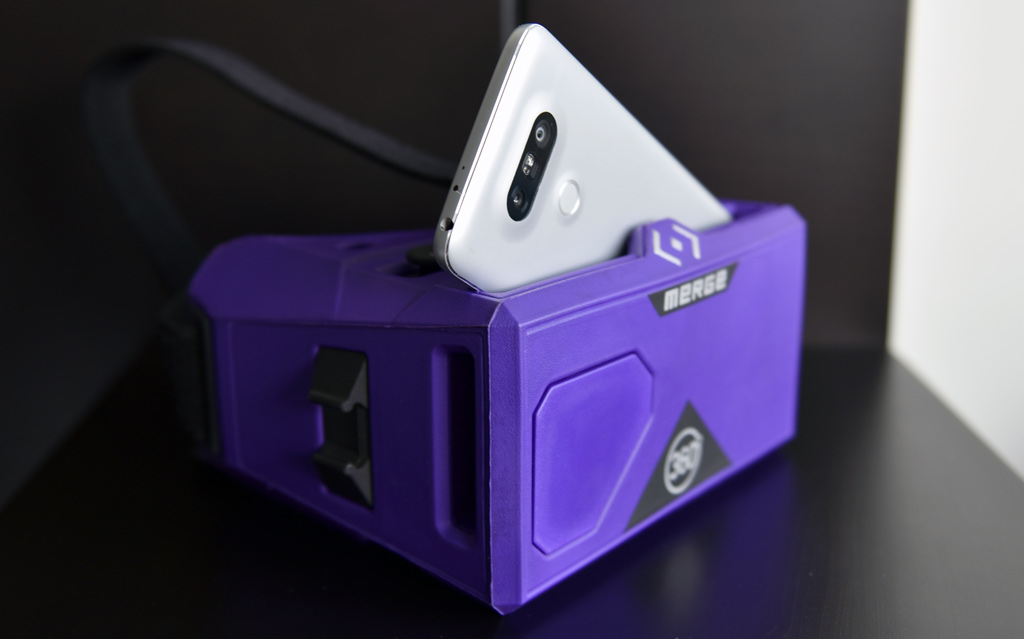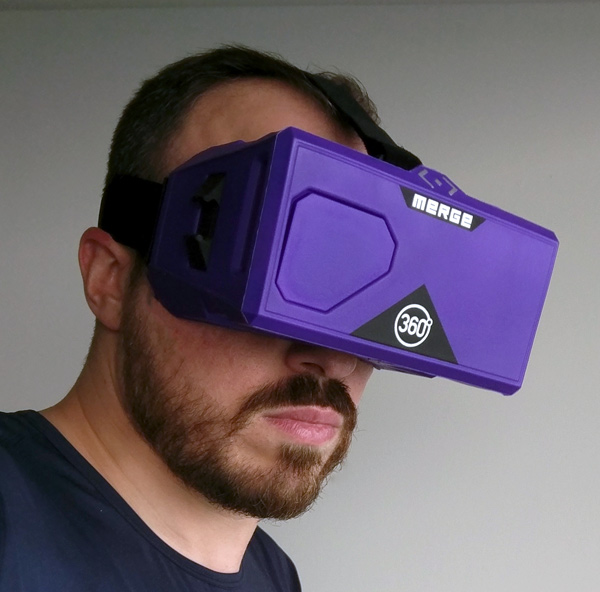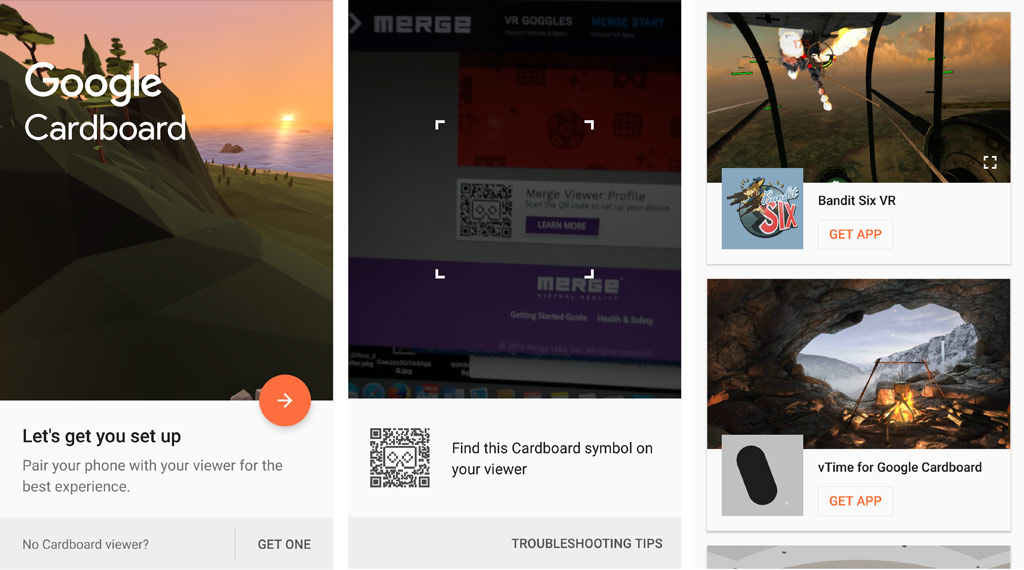
The Merge VR is virtual reality with an openness that is easy to appreciate, yet with limitations that keep it well within the entry-level realm. Compatible with a number of different iOS and Android smartphones, this is a headset that doesn’t require much to get involved, nor any real past experience to enjoy some of what it has to offer.
Unlike other VR headsets on the market, the Merge VR is as agnostic as it gets. It’s sort of a cross between Google Cardboard and Samsung Gear VR, both of which use smartphones to play the content that is then viewed in 360-degrees. It is also similar to those in that there is ready-made content that is ideally suited to the headset, with more functionality apparently coming in the future.
Design
 As the unboxing video shows, there isn’t much to the Merge VR. It’s a headset made of foam, with a purple shade that would stand out anywhere. The foam is malleable enough to squeeze some give out of it, but is actually stiffer than it probably looks in photos. Being made of such material also pretty much negates any fear of breaking something. The only moving pieces are the two lenses inside, which can be controlled by the two input buttons at the top.
As the unboxing video shows, there isn’t much to the Merge VR. It’s a headset made of foam, with a purple shade that would stand out anywhere. The foam is malleable enough to squeeze some give out of it, but is actually stiffer than it probably looks in photos. Being made of such material also pretty much negates any fear of breaking something. The only moving pieces are the two lenses inside, which can be controlled by the two input buttons at the top.
Perhaps to promote sharing, the foam is made of antimicrobial material, avoiding germs being passed around as different people strap on the headset. The straps use Velcro and are highly adjustable, so the headset could effectively fit any face and head. Of course, the main consideration with a VR headset’s fit is in blocking out everything else, maintaining a theatre-like darkness to see the content. The Merge VR does a good job of that.
The slot at the top is where the phone is supposed to slide in, with the screen facing in towards the lenses. The headset’s box says it can support the iPhone 6, Samsung Galaxy S5, HTC One M8 and other devices. That makes it sound out of date, but it really isn’t. Phone support is quite wide and varied, because just about anything with a 5-inch screen or less will fit snugly. You can stretch it out to about 5.2-inches, though the size of the phone then becomes a factor.
For example, the LG G5 fit with its 5.3-inch display. The iPhone 6s, HTC 10, Galaxy S7 and iPhone 5s would fit too. Going back a year or two, a significant number of phones could fit. It’s the larger phablet devices that don’t, like the iPhone 6s Plus (or 6 Plus), Galaxy S7 Edge, BlackBerry Priv, Nexus 6P and others along those lines. You probably will have to take the case off if your phone is wearing one, however.
The cutout at the front of the headset is to make room for the phone’s rear camera, which could then be used for augmented reality content. I didn’t get the chance to try any of it for this review, unfortunately.

Setup
Merge VR has its own gateway to compatible content that is easy to find through its own website. Much of what’s available, which is a mix of apps, games and learning tools, is free to download and use, whereas others do cost something. Generally, it’s not more than $1.99 or $2.99, though could be higher.
Thankfully, the limited catalog doesn’t limit the Merge VR. The headset is capable of playing apps and games for Google Cardboard, as well as YouTube VR, Discovery VR and Jaunt VR. That opens up a wider range of content and ensures you won’t run out of stuff to watch or play over time, even if Merge can’t keep up.
However, the phone does have to be set up for VR to display through the headset properly, especially when using Cardboard. There is a free app specifically to set that up, and the steps are easy to follow. It’s basically scanning a QR code from the Merge Start website to link the phone to the headset.
Performance
There’s a lot to watch and play with, and I wasn’t able to get through a majority of it throughout my review. Whether it was a VR rollercoaster, walking the tightrope between the Twin Towers in New York like Philippe Petit did in 1974 or playing with fish in an aquarium, it was hard not to like the various experiences.
This didn’t surprise me because VR, at least in its current form, is new and experimental. The feelings it can evoke are palpable. The setup is important because, without it, content doesn’t play properly. I point this out because it counters the simplicity with which the Merge VR is designed to operate. The instructions that come with the unit aren’t in-depth, so taking a little time to go through the steps will ensure smoother viewing.

The right trigger button found along the right can be used in certain games as a controller to throw things or fire at enemies. Since the headset doesn’t have Bluetooth or a hard connection to the phone, using a gaming controller paired with the phone is a good alternative, and one that I would certainly recommend to avoid fatigue.
Many of these apps and games are shorter experiences, so switching between them and selecting others to download requires taking the phone out of the slot and doing it manually. Not the most convenient situation, but a trade-off when dealing with a VR headset that doesn’t have all the bells and whistles.
A consequence of playing VR content on any phone is that it will run hot after a while — very hot, in fact. Battery life also takes a significant hit, where 30 minutes of VR use could take up to 20-25% off.
Final Thoughts
It’s not in the same league as truly immersive headsets like the HTC Vive or Oculus Rift, but for an entry-level user that wants to see what it’s like, the Merge VR isn’t a bad way to go at all.
Those who own any of the Samsung devices compatible with the Gear VR are better served by going with that headset. They simply work better together, and the Gear VR is sturdier and more comfortable to wear for longer periods.
The Merge VR is available now.



